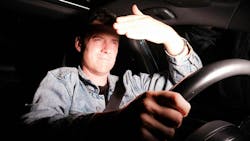IIHS-HLDI Study Finds Headlight Glare Not Causing More Crashes
Complaints that today’s headlights are more likely to blind oncoming drivers have gotten louder in recent years. Insurance Institute for Highway Safety-Highway Data Loss Institiute research shows glare is just a tiny fraction of nighttime crashes, and that percentage has hardly changed over the past decade.
From 2015 to 2023, headlight glare was cited as a factor in only one or two out of every thousand nighttime crashes across 11 U.S. states, the new study shows. And while the amount of light given off by headlights increased over this period — slashing crashes caused by poor visibility — there was essentially no change in how often glare was mentioned in crash reports.
“Although it can certainly be uncomfortable, headlight glare contributes to far fewer crashes than insufficient visibility,” said IIHS President David Harkey. “But that doesn’t mean reducing glare isn’t an important goal — one that we’ve long focused on at IIHS in addition to improving illumination.”
Headlight Design Shift
While federal headlight standards for minimum and maximum brightness have not changed since 1997, the headlight rating program IIHS began in 2016 has helped to drive a shift in headlight design in the U.S. fleet.
The Institute’s ratings are technology-agnostic. The program has led manufacturers to use LED headlamps on more models. IIHS ratings penalize headlights whose low beams produce excessive glare that can temporarily blind oncoming drivers. When the Institute released its first headlight ratings in 2016, only one out of more than 80 headlight systems evaluated received a good rating, compared with about 51% of the headlights IIHS tested on model year 2025 vehicles. There have been similar increases in acceptable ratings. Only about 16% of the headlights tested today are rated marginal or poor, compared with 82% in 2016.
Those changes have resulted in a dramatic reduction in crashes that occur due to poor visibility. A previous IIHS study of police-reported crashes showed that vehicles with good ratings for visibility in the IIHS headlight test are involved in 19% fewer nighttime single-vehicle crashes and 23% fewer nighttime pedestrian crashes than vehicles with poor-rated headlights.
The effects of different levels of glare are harder to isolate. Most glare-related crashes are cases in which the driver affected by the glare runs off the road. The glare-producing vehicle isn’t involved in the crash and thus can’t be identified. There’s no way to know how its headlights perform in IIHS tests or whether the driver neglected to switch from the high beams to low beams.
For this reason, the new study approaches the issue differently, looking at how often glare is cited as a factor in crashes and how that has changed as headlight ratings have improved.
Tracking Glare in Crash Reports
IIHS Principal Research Engineer Matthew Brumbelow examined data from 11 states in which police can list glare as a contributing factor in crash reports. Out of around 24 million total crashes, fewer than 150,000 had glare coded as a contributing factor, and a far smaller fraction were both coded for glare and occurred at night. With a few exceptions, these nighttime glare crashes accounted for only one or two out of a thousand crashes per year in all 11 states.
The glare rate remained relatively constant over the study period and did not show a steady increase coinciding with the improvement in IIHS headlight ratings. In fact, the glare rate was highest in 2015 and lowest in 2020.
Relative to crashes without reported glare, crashes with glare were more often single-vehicle crashes, occurred more frequently when it was raining or the road surface was wet, and happened more often on local, undivided, two-lane roads with relatively low speed limits. In addition, drivers in crashes with reported glare tended to be older in age and driving older vehicles.
That doesn’t mean manufacturers and safety professionals should not be working to reduce glare further or mitigate its effects, however. Reducing lane departures, high-beam assist, and adaptive driving beam headlights all offer the potential to further reduce glare-related accidents.
The full report is available here.
